Safari World Landscapes / Processing A Portrait

|
• Bergstadens Hotel • Thon Hotel Sandnes • Rica Saga Hotel Sarpsborg • Best Western Skei Hotel |
Thank you for your generous contributions. We've been making some great headway over the last few weeks and soon I'll be running some test images. These test images take a considerable amount of time and computer processing power so once we
start we won't be accepting any new images. Please send in your images now so you can be sure to be included in this great project. I have big plans for these mosaics.
We are still accepting (and pleading for) images of children from SEA. No matter how terrible you think they are, please send them in anyway. These images will be used to complete a set of 3 high quality mosaics which will be sold to benefit the Karen and Burmese Orphans living in the orphanages and refugee camps. The more images the better, I can use all you have. Please take the time to go through your images for anything you think might help. If you missed the "No Place to Call Home" special, you can click on the link and read more about this. Thank you! QandA@Bkkimages.com
Quick Click Links
Feature Photograph
Safari World Landscapes!
Processing a Portrait
Photography News of Interest
Readers Submissions
Readers Questions A Snapshot of Bangkok Images Week in Review
Infocus Blog, Leadership Basics for Websites
Feature Photograph *menu

Canon 5d Mark II, Sigma 12-24mm F4 @F11 1/200th 24mm ISO 100
A few weeks ago my client, a guest, my assistant, and I.. were cruising the Ang Thong countryside looking for interesting photo opportunities. Have you ever driven around areas like these? The main roads don't look like much and it seems all you
can see are uninteresting flat fields of nothing. I could feel the tension, everyone was thinking "is Steve crazy?" "What are we doing here?" I kept driving.
I've always told you 90% of photography is in being at the right place at the right time. How can you ever be there and get the pictures no one else gets if you're not willing to suffer a bit and pay your dues by leaving the well trodden path
and taking chances on your own? Or in this case have a bit of faith in your local photo guy? (me)
Smiling I turned off the main road and headed down some dirt roads between rice fields. No, I've never been here before but I've been to many places just like it. It's farm land. We'll find fields, workers, machines, water, trees,
and much more. It's just a matter of patience and the willingness to explore. Do you have explorers blood flowing through your veins? I think I might..
Bouncing along the dirt roads things started getting more interesting and I started pointing things out like the direction of light, natural contrast, the uniqueness of our location. We kept bouncing. Rounding a corner there it was. The scene we'd
driven all this way to photograph. Does it surprise you no one saw it?
That's okay I'm a patient guy. I pointed out the nice sky with clouds, the contrasting burned BLACK foreground, and the tree line with reds, yellows, greens, and someone was nice enough to put a dirt road in the perfect place to lead the viewers
eye through the frame. It only took seconds, 3, 2, 1.. Everyone saw it at once and piled out of the truck with cameras at the ready instantly evaluating the scene and trying to come up with the best composition in their minds eye.
These are the hot months in Thailand, everything is either dead or dying and turning brown. A scene with this much natural contrast, an actual blue sky, colors, we were truly blessed. I guided them through some thoughts for exposure and framing and picking
up my own camera I couldn't resist taking my own. This image is significant because it's a great example of getting a great landscape through shear determination and patience. Not to mention exploring!

Canon 5d Mark II, Sigma 12-24mm F4 @F11 1/125th 35mm ISO 100
There were at least 10-15 different ways to photograph this scene, and more ways to process it. With these samples I wanted to show the colors, the high level of detail, the shadows on the road, the outlaying field of green, and perhaps why using a polarizer
in such circumstances might not be the best idea.. 🙂 You should know by now I like to share my mistakes right along with my successes.
It's a Sunday afternoon. You have a choice. Stay home and read a book. Go down to the pub and watch football on the big screen and drink beer. Eat at a nice restaurant. Or get in the car, head to the Ang Thong countryside one hour outside of Bangkok
and turn off on a dirt road and see if you can find the perfect landscape..
Safari World Landscapes *menu

Canon 5d Mark II, 16-35mm F2.8L @F8 1/80th 35mm ISO 100
Someone recently brought to my attention that although I've shown many nice animal shots of the animals at Safari World, that I've been remiss in showing landscapes or anything that wasn't a tightly cropped image of an animal. Mostly true
I decided so searching through my files I came up with a handful of landscapes I'd like to share with you this week.

Canon 5d Mark II, 16-35mm F2.8L @F8 1/320th 33mm ISO 100
Looking at this image you're left wondering where all the animals are. This is the start of the wetlands area and even though you can't see them are thousands of sea birds in the trees.

Canon 5d Mark II, Canon 300mmmm F2.8L @F4 1/1250th ISO 100
This is a special shot. Two Big Ugly Birds in the same frame with their eyes both achieving critical focus. This is a lot more difficult and rare than you might suspect at first. Unfortunately the light angle is such that you can't see their blue
eyes.

Canon 5d Mark II, 16-35mm F2.8L @F8 1/125th 35mm ISO 100
As we move closer to the tree line you can see the bodies of water, small islands, and just how open and spacious this park is. Is there really this much room in the middle of the city with nothing but animals and nature? Yes.

Canon 5d Mark II, Canon 300mmmm F2.8L @F4 1/1640th ISO 100
With the cloud cover the sun induced reflections aren't present, but there is enough light for the main reflections of the storks.

Canon 5d Mark II, 16-35mm F2.8L @F8 1/500th 35mm ISO 100
This is a view of one of the small bodies of water in the wetlands area. Sometimes its full of birds fishing and looking for insects, other times like this its mostly empty. What many don't understand initially is that there's no nets or cages
for these thousands of birds. The park people simply built a nice artificial wetlands like area and the birds came. The birds continue their natural migration patterns throughout Thailand and the SEA region. Sometimes you have many birds, sometime
not so many. It depends on the season.

Canon 5d Mark II, Canon 300mmmm F2.8L @F4 1/320th ISO 100
This is the mate of the big red lion you've seen previously. Her hide is well beat up and the years show, but she still exhibits a ton of power.

Canon 5d Mark II, 16-35mm F2.8L @F8 1/400th 35mm ISO 100
Another view of the bird area, water bodies, and you might be wondering what the artificial cone shaped covers are for? They provide shade and protection from the elements. When they first built the place the trees and other vegetation were not as mature
as they are today so these were needed.

Canon 5d Mark II, Canon 300mmmm F2.8L @F5 1/160th ISO 100
The tigers tend to take naps and lay around in the heat of the day and today was no exception. This guy sat up to take a look at us just to be polite.

Canon 5d Mark II, Canon 300mmmm F2.8L @F4 1/320th ISO 100
This is a restaurant area where you can eat and mingle with the giraffes. You can feed yourself and the giraffes at the same time.

Canon 5d Mark II, Canon 300mmmm F2.8L @F5 1/320th ISO 100
This tiger looks like a housecat as he tries to sneak up on a bird. Unfortunately he had a thorn (or something) in his rear foot and when he sprang up to get the bird the most he could muster was a lame
trot. The birds were laughing at him. It tried to get my client to get out of the truck and pull the thorn out of his foot, that way he'd have a tiger friend for life. He didn't want to.

Canon 5d Mark II, Canon 300mmmm F2.8L @F8 1/160th ISO 100
Not everyone is sleeping. This grump guy walked up to within a few feet of the truck and showed us his recent dental work.

Canon 5d Mark II, 16-35mm F2.8L @F8 1/250th 35mm ISO 100
This is more like it. Back as the wetlands there's an old wooden dock the bigger birds build nests on, water bodies, trees, a bit of everything.

Canon 5d Mark II, Canon 300mmmm F2.8L @F5 1/320th ISO 100
This is one of my best images from Safari World. He doesn't mingle in the wetlands area, the tiger and lion pen isn't very user friendly to a plump bird, and the bear area isn't too friendly either. This guy found a small strip of the park
where nothing else really lives and decided to visit. I'm kinda curious where he came from and where he's going..
Safari World has a lot to offer the Bangkok photographer. Soon I'm going to try and get into the private parrot area.
Take care and we'll see you there
Processing a Portrait *menu
Last week's column featured a pretty model and I used one of the images from that shoot on my new banner you might have seen floating around the site. A few people asked for a better look at a certain image in that banner and asked how I processed
it. This week's learning topic will focus on the processing of a single image. We'll go through step by step what this image needed to be successful. First the image in question.

Canon 5d Mark II, Canon 85mm F1.2L @F2.8 1/800th ISO 200
I processed this picture in a style very popular back in the states in the 40's and 50's. Her hair style and the cuffed blouse made me think of this style. The beauty dish lighting effect (natural light, we got lucky) sealed the deal.

The first step is to go over the shoot and make your selection. If you remember I was shooting over my client's shoulder so my framing and whatnot wasn't as good as it could be. Mostly when looking at these images I was looking for the facial
expression first, the pose second, and finally the technicals like exposure and sharpness. Once I find something I like I get a closer look.

It helps to bring up the cropping tool and frame the subject. Rotate it side to side a bit and get the most powerful angle. 1-2 degrees can take a person from a weak look, to a position of power. Small changes can make dramatic differences in the overall
effect of a portrait.

Make your crop and other adjustments for exposure, white balance, etc.. and then import the image into Photoshop.

The import dialogue box gives you several choices. I usually work on copies and not the original.

Once in Photoshop the first thing to do is adjust your levels. Make sure you're not clipping highlights or losing too much shadow detail and you have the desired exposure.

This young beauty really does have sparkling white teeth, very beautiful with the nice pink gums only youth can provide. However, when you adjust your white balance to remove the green cast (from the green grass and hedges behind her) and get the most
pleasing skin tones (remember, an accurate white balance is often not the most attractive white balance), you often end up with less than white teeth. No worries, just use the selection tool to isolate
the teeth and then bring up the "replace color" dialogue box and adjust the color to the most attractive shade of white you think fits.

Next, zoom in with your mouse's scroll wheel (you have programmed your mouse to take advantage of Photoshop haven't you?) and take a good look at her skin for blemishes. Everyone has blemishes.
All the black spots on her face represent a blemish that I corrected using the healing tool. The healing tool set to "proximity match" works great for removing most blemishes.

The next task is to smooth the skin. If you don't have a plug-in that makes it easy, simply mask off the eyes and other areas of the frame you want to remain sharp and then apply a Gaussian blur to taste. It's better to apply several Gaussian
blurs in increments of amount/effect than all at once. Because I do portraits all the time I purchased the Kodak GEM Airbrush Pro plug-in for Photoshop that automatically masks the eyes and makes a nice softening effect.

The last step is applying the black and white toning. There are several ways to do this in Photoshop including their new black and white filter which is shown. Photoshop veterans will probably use other methods.

The last thing you might want to do is add a border. I like the simple drop shadow borders and CS4 includes a nice action for this border (and others) which makes it really easy.

While I loved the black and white version I was asked what it would look like in color. I have this one processed to be printed on canvas so it might look a bit heavily processed to you, but still the effect is pleasing to the eye.
One step you might think I missed was sharpening. No, I didn't sharpen this image. I knew when I started I wanted a soft look and the 85mm F1.2L lens used properly provides a fairly sharp file to start with.
It's important to note that all these steps are "to taste." Some you might like, others not, so go through your images and create 4-5 different versions until you come up with something your
happy with. I'm very happy with both versions of this image and the model is too.
Photography News of Interest *menu
I'll bet a lot of you have rather plain looking garage doors? Not a problem any longer. Sendthis company
your favorite image and they'll make a skin for your garage door which has the potential for being quite unique. And if you miss Thailand..

Were you one of the 5200 naked Australians hugging and kissing for Spencer Tunick's photo shoot at Sydney's Opera House? I have enough of a problem getting one person to pose nude, this guy gets thousands at a time! I don't especially like his images but you've gotta admire his skill in organizing these things.

I'm intrigued. You guys already know I like fast glass, but a .95 aperture? That's better than 77 virgins.. Noktor markets some unique
lenses for Canon, Nikon, and now the 4/3's format cameras. If you need the fastest lens on the block now you know where to go.

Panasonic releases their new 14-42mm Lumix G Vario F3.5-5.6 ASPH MEGA O.I.S lens for the micro 4/3's
system.

Panasonic also announces
their new Lumix DMC-G2. This is the latest version of their popular series that started with the G1. A really high-tech EVF (electronic view finder),
an articulating 3" LCD, and now it records 720p HD video which many have been waiting for. The LCD is also a 'touch screen' so you can tap the LCD to make camera settings. Panasonic just keeps improving on this model and making
it better and better.

Another release from Panasonic
is their very small DMC-G10 Lumix G Micro Systems micro 4/3's format camera. This is being billed at the lightest body available for an interchangeable lens camera. This could
be very desirable for those travelers who want great image quality but don't wish to carry around the heft of a more traditional DSLR. 12mp, 3" LCD, and a viewfinder!

BEWARE OF THIS DEVICE. If you have the Energizer Duo Charger system be aware that the Department of Homeland Security's United States Computer Emergency Readiness Team (that's a mouthful) recently announced that this device has a backdoor that listens on port 7777 which could allow a remote computer to take charge of your computer! And uninstalling the software doesn't
remove the trojan! If you have one of these modern day trojan horses you'll want to read this article.

Readers' Submissions *menu
Hi
This is from a photo shoot I did in Kuala Lumpur , Malaysia
Regards
Bart



Bart –
More great images! Thank you! Folks, I recently had the opportunity to meet with Bart over lunch and talk to him about his work and travels. He really gets around! If we're lucky we'll be getting an inside look at his travels and work in the
future. For now you can check outhis site here.
Steve
Hi Steve,
When I was in Nha Trang a few years ago I met an Aussie woman by the name of Jan Montone. Jan lives there pretty much fulltime and was soliciting donations from family and friends to buy tricycles for the many disabled people up that way. She would give
away 4-6 per month on average. She'd have a presentation day when the trikes were delivered from Saigon and I photographed some of these special days for her, captioned the photos, and then sent them off to the people who'd donated the
money. They were very well received. She told me some people were donating money ($120 US per trike from memory) in the names of their grandkids, downloading the captioned photo thanking them, having it frame, and giving it to the kids in lieu
of Xmas or Birthday money. Have attached one of those presentation days for you.
Kevin.





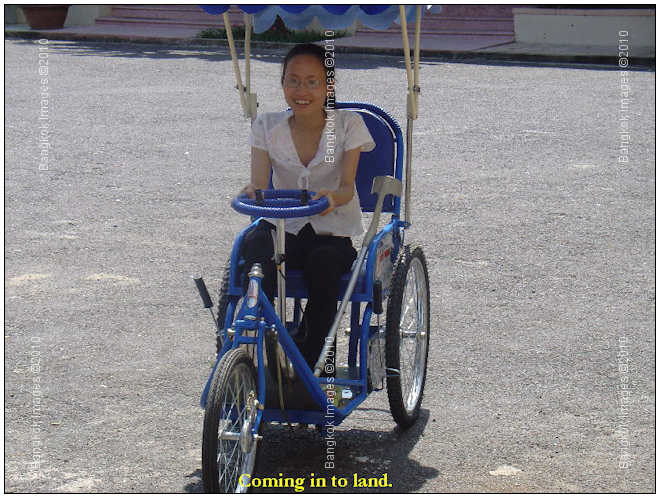
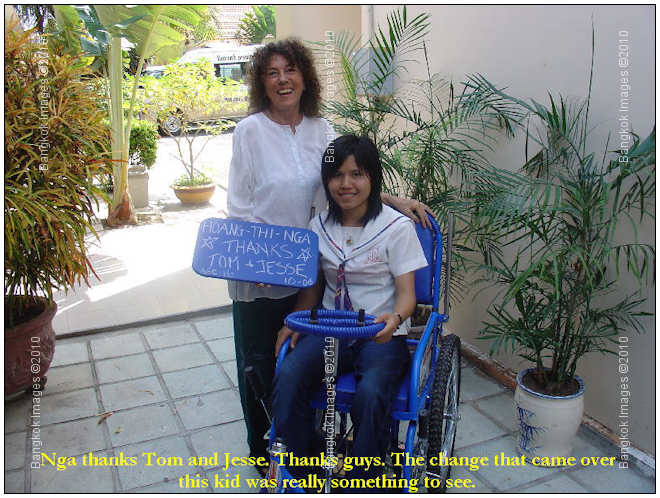
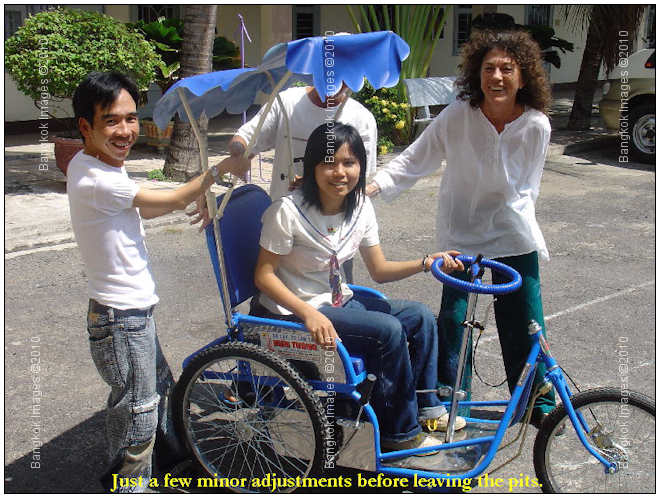
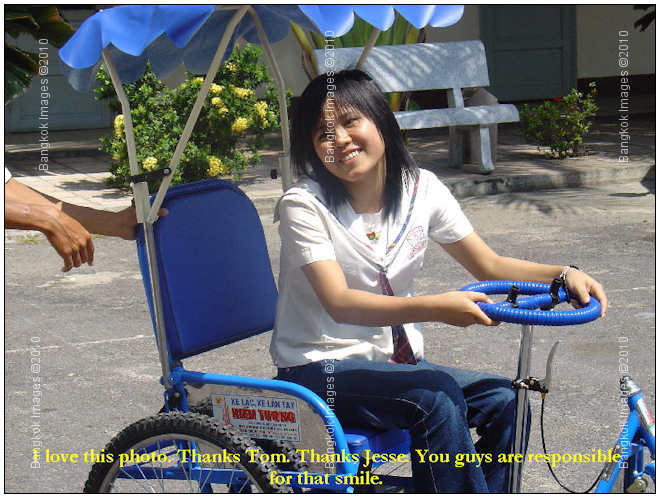
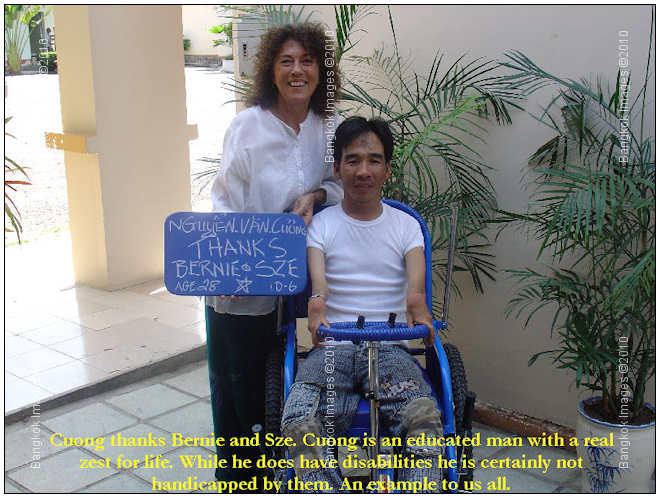
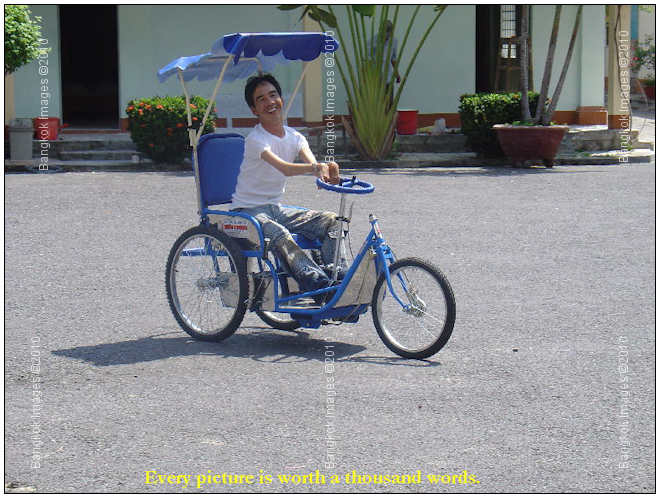
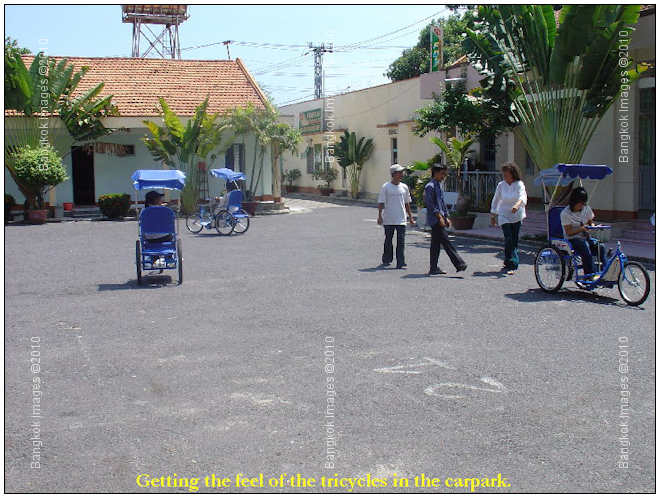
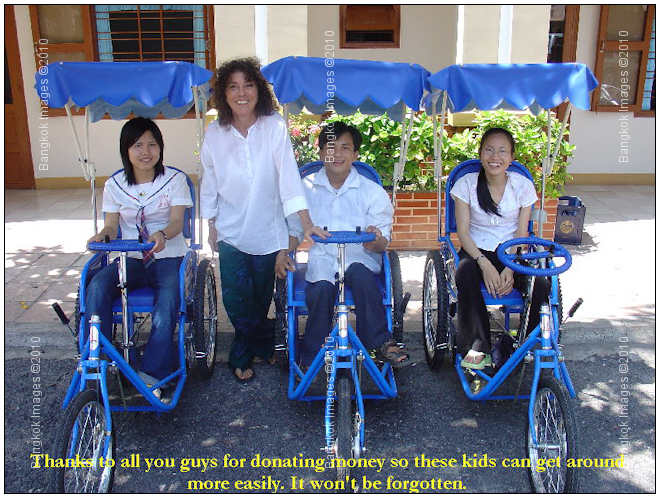
Kevin –
These are wonderful images and I can't say enough about the good people who make these things happen for the less fortunate. (I asked Kevin if there was a website or contact point we could publish so readers could help if they wanted, but he took these images so long ago he has no contact information.)
Steve
I suspect the readers submissions will be a highly anticipated section of this column and I encourage anyone with photographs and travel accounts they'd like to share to please send them to me at: QandA@Bkkimages.com
Readers Questions *menu
Hi Steve,
I have got a couple of questions for you, one is more of a question of curiosity and the other is a technical question.
1. I was best man at a wedding this week. The groom had sent me screeds of information about the wedding beforehand and amongst what he sent was the photographer’s name. I checked him out online and his work was really good. I was looking forward
to watching him work and of course was a little curious about what gear he used. So you can imagine my surprise when he turned up with just two bodies, a Nikon D300 and a Nikon D70. The D300 is a nice piece of kit. The D70 is a perfectly competent
camera for an amateur or keen enthusiast but I just would not have thought it to be a pro’s choice. What surprised me even more was that the two lenses he had were Nikon zooms, and no, we’re not talking the very nice 24 –
70 here, but something else. They seemed to be in the 20 – 100 or so range but I don’t know for sure what lenses they were – but sure, not the 24 – 70 which is distinctive by its size. After the wedding I went back
to the guy’s site and looked at his photographs and when I paid really close attention, it seems to be this guy is a bit of a Photoshop guru. So, my question here is….what do you make of this guy’s gear and how much of a part
in the whole equation does Photoshop play for a pro?
2. I read on a forum recently that some of the ISO settings in my camera are not real, but processed and I should avoid using them as they are essentially made up with the camera “faking” the ISO. It was said that 100, 200, 400, 800, 1600,
3200 and 6400 were real, but those in between ISOs – which I use a lot, like 2000, 2500, 4000 and 5000 –produce an image with less dynamic range. I personally have not noticed this but that is not to say that it is not the case.
Do you have any thoughts on this?
Cheers
Stick
Hi Stick –
These are some great questions!
Question 1. This is an interesting question. I remember after my first two years of shooting weddings I was a guest at a friends wedding and the photographer who charged 4x more than my rates showed up with
a cheap Olympus E3 and low end flash. The pictures were terrible.. but in his market he was considered inexpensive and had all the work he could handle.
Wedding photography is one of the first areas an amateur takes on professionally, yet it should be the last. They buy a $500 DSLR, a few business cards, and advertise themselves as wedding photographers. Some become successful, but most barely get by
and end up leaving the market. In truth, wedding photography is one of the most challenging assignments I've ever had for a variety of technical reasons. Thai weddings are the absolute most difficult, which is why Thai photographers don't
do them.. or won't do them live. I might be the only person in Bangkok willing to photograph a wedding live.
With all that said, if using decent lighting, or shooting outdoors in good light, it's entirely possible to shoot a nice wedding with low-end equipment. In fact, most wedding photographers out there do just that.
Where the differences become apparent between gear is when specific requests are made such as a "no-flash" wedding where fast lenses and good bodies are mandatory. Did you know that over 90% or the famous Canon 200mm F1.8L lenses went to Korean
photographers during the "wedding boom" where couples would spend a small fortune on their weddings? They all wanted the best quality, low light, etc.. and would pay 10,000-20,000 USD's for the service.. so Canon ended up shipping
most of these great lenses to S. Korea where the demand for them was.. It's where I got mine.. 🙂
Also, having great gear doesn't mean you can shoot great weddings. Like I said, weddings (done properly) take the most skill and present the most challenges to a photographer of any other genre I can
think of.
Photoshop. Let me preface this by saying 'real pros' want to do as little post processing as possible. Post processing takes time and time is money, so why spend time post processing if you don't need to? If you're lacking in skills
you'll be spending lots of time post processing just to make your work acceptable. Many use heavy handed Photoshop techniques that fool many into thinking the pictures are good, but they're really a type of mask.
With that said post processing is very important in any kind of photography, but wedding photography tends to see a lot of it. Most couples looking for a wedding photographer are young and not a good judge at all of quality photography.. and often go
for gimmicks and cheap Photoshop tricks. This was a source of constant surprise to me during my time shooting weddings in the states. If the couple were paying the bills themselves they'd look for the cheapest regardless, but when the parents
were paying they'd obligate the parents to huge fees to get gimmicky looks. And with that said, there are an awful lot of Photoshop plug-ins that provide these effects popular with weddings and those who can't do.. buy plug-ins.. As
you know plug-ins for Photoshop automate certain "looks" and "themes" and even a novice can use then with five minutes of instruction.
Okay, with ALL that said weddings are more about marketing, and knowing your market, than photography skills. I've said this many times before about professional photography, it's 90% business skills and 5% photography skills and 5% luck.. With
weddings it more like 98% business skills. Impulse buying, pleas to emotions, various people paying, etc.. all add to the minefield of wedding photography.
Question 2: This depends on the camera. I can tell you from personal testing that ISO 50 (you can enabled "extended ISO's for ISO 50) on our Canon's
produces slightly less image quality overall than ISO 100. Many people initially thought ISO 50 would provide lower noise than ISO 100. It doesn't. Your cameras "native ISO" (with Canon's this is ISO 100, and Nikon's ISO 200) will provide the best image quality. The in betweens.. I just don't know. I'll watch for more information on this question and get back to you. I can tell you this, most pros will only use 100, 200, 400, 800, 1600, 3200, etc.. because
pros think in "stops" and it makes things easier. The only people using the in betweens are those using "Auto ISO" in the newer bodies or P or
green box mode in old or new cameras.. I'll keep an eye out for this information and bring it up next time I talk to my CPS (Canon Professional Services) representative. I caution everyone to not put
much stock to what they read on the web unless it's from very reliable sources, and repeated on other reliable sources.
Steve
Please submit your questions to QandA@Bkkimages.com All questions will be answered and most will show up in the weekly column.
A Snapshot of Bangkok Images Week in Review *menu
Business has been really good these last few months! This week we've had four workshops and visited some fun places. I'm not sure yet what next week will bring, but it does seem to be a good season for visiting photographers. If you think you'll
be in the area in the coming months and would like to take one of my workshops please shoot me an email. Steve@bkkimages.com
We've made some major equipment purchases over the last two weeks and are waiting for delivery. We've ordered a couple high-end 26.5 inch wide gamut monitors and processing software, the industries fastest SSD to use as a system/program drive
in our main workstation, a 6gps SATA III and USB 3.0 sub-motherboard, a new 50" Plasma HDTV for display purposes (with home networking capability), and a new GPS with junction view, lane assist, and voice recognition. As these items come
in we'll put them to work as soon as possible and then bring you a review on each item.
Infocus Blog, Leadership Basics For Websites *menu
Leadership Basics, They Apply To A Website Too!
Warning, this is a Rant!
Well, at least a few of my opinions will be known and I'm pulling no punches. You the unique visitor are what every blogger, webmaster, columnist, and website out there wants more than anything else. Unique visitors are the modern gold in the 'web
rush' we've been experiencing.
Unique Visitors
Unique visitors are IP specific 'clicks' on a website. Every site has people who check it 1000 times a day, clicking on the bookmark 1000 times a day is only of marginal value to a site owner over
someone who clicks just once a day. A savvy advertiser paying good money (or magic web wampum thingys) to advertise on your site is looking for 'unique' visitors.
How many 'unique' individuals actually visit your site in a day, a week, a month or more. They want to know how many individuals will see their advertisements and ideally they want to know more
such as the age group, gender, and other interests which helps them direct the sale of specific products. A photography site is easy, its a great place to sell photography stuff. A writers website is easy, most writers love to read so it's
a great place to sell books.
Earning Your Click!
Yes, you read that right. Anyone running a commercial website, or any website that generates income through advertisements, must earn your click. Why? Because each time you click on their site they get paid. It might only be increments of a cent, it might
only be from the rates they can charge advertisers based on the popularity of the site, or it could even be Google ads, but each time you click on the site you're generating income for the site owner. It's a fact of web life, it's
how it works. If you didn't know it before you know it now.
How can the website owner earn your click? To start, but making the site worth your time to visit. It starts with a basic easy to navigate web design, readable fonts, attractive colors, and ends in the ever important content. But there's more, once
you stop appreciating that fancy look and reading the informative content, then you need to look at customer service.
Site Evaluation and Feedback
Does the site work as it should? If it allows you to input content, does it make it easy and accurate, or does it make it a major pain in the azz? If you fill out a contact form does someone get back to you the same day, or weeks later, or not at all?
If you do manage to contact the site owner and take the time to provide feedback (feedback is even more valuable than your unique visitor click, feedback no matter the source and no matter what is said, is valuable information you wouldn't have otherwise had to help you make decisions on your site, how you use this feedback determines your success of failure as a website owner),
how does he/she respond? Are they helpful, do they answer your questions, or do they exhibit an undesirable attitude?
Do they make you feel like they share your concern, or do they make excuses and tell you they don't care what you think or feel? Do they give you the impression the site is important to them, or something they grudgingly do when not otherwise doing
something more important? How they handle feedback, and this is different from actually implementing the idea/request/thought, is vital to your impression of their services and should very much determine if you return to that site.
The Reality Out There
For every person who provides feedback, there are probably 100-1000x that many people who share the same feelings but just won't take the time to drop you a line. If someone is unhappy, or having issues with a technical function of the site, or just
doesn't appreciate the pop-up ad, an astute website owner understands 100-1000x or more are unhappy as well.
A happy unique customer is unlikely to actively promote your site, but some do and it's appreciated. Mostly they expect things to work and for feedback to be handled appropriately, and they cruise on undeterred. However, an unhappy customer will
actively spread the bad word like a wildfire through a dry forest in summertime.. during winds with gusts up to 100mph!
They'll tell anyone who will listen, they'll write about it in their blogs, they'll enter complaints in the comments section, they'll do anything within their power to let everyone know they're unhappy with your site. Why? Because
when it comes to this point, they feel its the only way someone will listen to them. At this point it's all they've got, and they need someone to listen as a type of vindication if nothing else.
A Smart Website Owner
A smart website owner pays attention to unhappy customers, but they won't necessarily bend to them either. A smart owner will learn when and how much to explain, how far to go to satisfy the unhappy customer. Most unhappy customers aren't happy
because they feel no one is listening, or they aren't getting the service they expect, or maybe they're just not understanding what they should expect. A website owner, a website leader if you may, knows just how much information to
provide and how to word it, to give the customer the feeling they care.. even if they won't be following your suggestion to implement pink text. Usually this is all it takes.
Stupid Website Owners
Usually these guys have no concept of the value of a unique customer. More often these days they've had no real leadership or supervisory experience. It used to be we'd learn leadership basics in the military, or how to manage an office in our
first corporate position.
But with the ease a person can throw up a website these days, you could just as well be dealing with an introverted foul mouthed idiot whose biggest accomplishment is taking out the garbage in his mothers house he probably still lives in. There's
even the pointy headed geek who stays holed up in his parents basement playing video games. And unfortunately yes, the loser who for whatever reason has failed in any endeavor they've undertaken in their home country has now moved to Thailand
and starts their first business on-line.
It is very common, much more common than it should be, to encounter these types on the web.
How it Should Be
A website that derives income from advertising is a business, and should be ran like a business. You should not run a business if you don't have time to do business things. You open the door each morning and lock it each night at the very minimum.
During that time you're supposed to take care of customers.
Unless you have time to do it all yourself, you'll need others to help. You'll need to delegate responsibilities and this means giving up control. This can be terribly hard for the inexperienced controlling types, but remarkably easy for the
seasoned leader who realizes and understands that his/her personal success, hinges tightly on how successful he can make his/her employees. In other words, if they take care of their employees properly they needn't worry about giving up control
to those same employees. Unfortunately the unseasoned and inexperienced leader hasn't yet developed the skills and confidence necessary to give up control.
Depending on your site you'll need different skill sets, and not every site owner is gifted knowing it all.
A Comparison
The mentality of putting up a website as a business can easily and accurately be compared to opening a restaurant as a business. Restaurants have long been seen as an easy target for the beginning business owner because the uneducated and inexperienced
beginning business owner thinks running a restaurant is just one step up from cooking in his mother's kitchen.
I worked full time in restaurants from the time I was 11 years old. I know what it takes and how to do it because I started cleaning tables and peeling potatoes and was brought up by a family to management level. I was taught every nuance of running a
restaurant from the ground up. I was taught the hard way, and the right way. Most often the hard way was the right way. If you're not willing to work 16 hours a day seven days a week at full speed ahead, don't try and run a restaurant!
I managed the most successful H. Salt Fish&Chips restaurant in America when I was 17. For my 18 months we brought in more money than any other franchised member. Before and after my time as manager they brought in less. I had learned well.
8 out of 10 restaurants fail in their first year, often taking every penny of savings and every ounce of self-respect the owner had left. In our current economy it's probably closer to 9 out of 10.
Websites are no different, people start them because they think it will be easy, they're not prepared to put in the hours or hard work, they have no practical leadership experience, they haven't yet learned to listen to customer feedback, and
subsequently they're not equipped to deal with the other professionals (i.e. advertisers, suppliers, inspectors, officials) necessary to run a site.
A website invites you in the door by an attractive skin. A restaurant invites you in the door by an attractive entrance. Once inside a website or restaurant the customer expects to be able to find things (tables, menus, features and visuals),
and they expect to be served. They expect to be served quality food/content, and they're used to consuming food/content a certain way. They'll often provide feedback if these areas are lacking.
Restaurant managers MUST be a people persons first, and cooks second. Website owners must be people persons first, and programmers second. Both often try to isolate themselves from the general public and this is always a huge mistake. Be prepared to spend
lots of time not only with your cooks, suppliers, bar managers, wait staff, accountant, but also your customers. You need to get out there and LISTEN. Your success as a restaurateur is heavily dependent on your ability to read customers in many
ways. Do they feel comfortable in your restaurant, are they enjoying the food, do they find the value high, how are they getting along with the wait staff, are the take home bags working as they should?
Final Words
Don't start a website if you're not prepared to spend a lot of time and energy maintaining it. It's a huge mistake to think websites run themselves. If people knew how much time and effort this column took me each week they'd think
I was crazy, but I look at this column as an investment. I want it to grow and become better and subsequently have a growing readership. If I wasn't willing to put in the time and constantly evaluate (listen) my feedback then I'd be wasting my time.
With only so much time each day to devote to web surfing I've become very selective on what sites I visit more than once. I expect a lot from a site if they want me to be a regular visitor. If they want me to contribute in some way then I expect
more. I expect GREAT customer service, feedback, and a positive professional attitude. I think you should too. Don't waste your time supporting websites that aren't worth your time. Move on. Click on one of the other hundred million
zillion sites out there.
Your click is golden. It's like your vote. Make them earn it.
Until next time..



